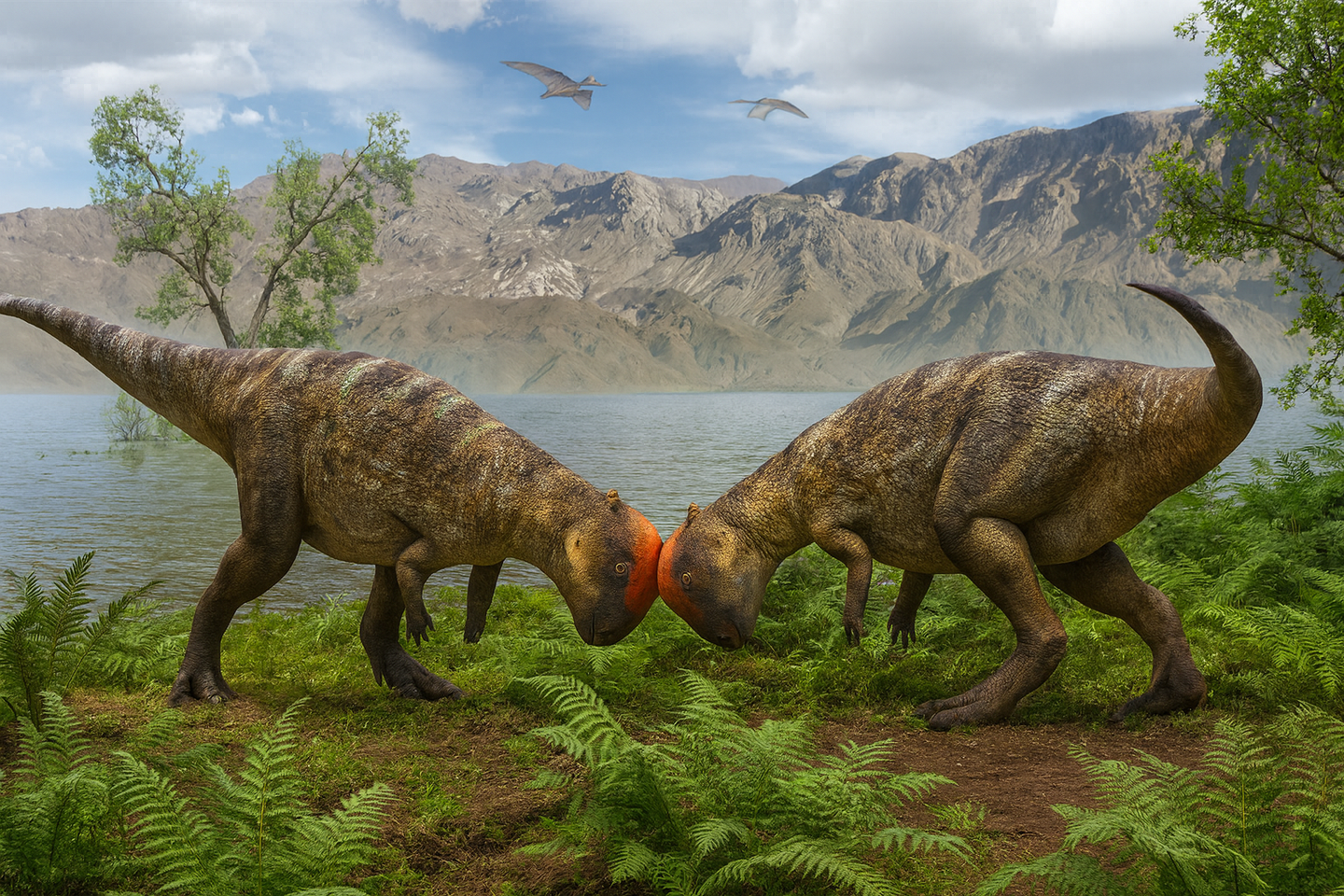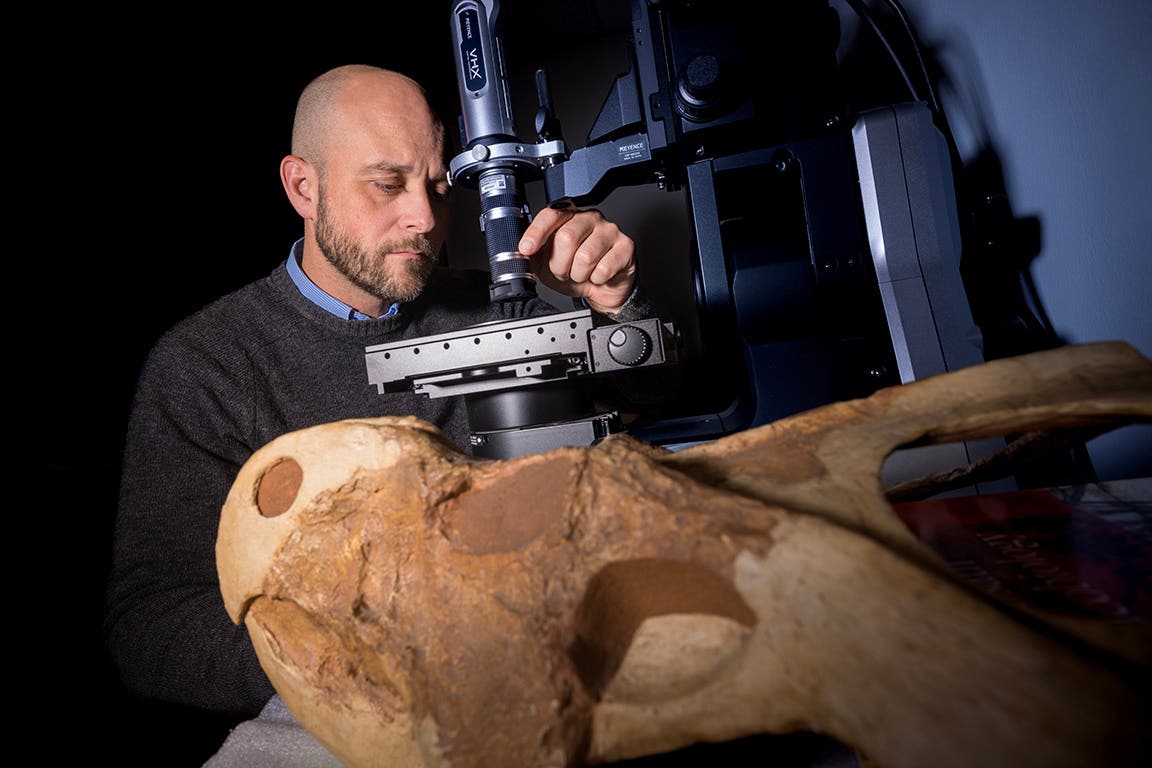Mongolian fossil fills 15-million-year gap in dinosaur behavior and evolution
A small dome-headed dinosaur unearthed in Mongolia is changing how scientists understand dinosaur growth, behavior, and evolution.

 Edited By: Joseph Shavit
Edited By: Joseph Shavit

Before this discovery, the earliest known pachycephalosaur fossils were 15 million years younger. (CREDIT: AI-generated / The Brighter Side of News)
It was a gray morning on the steppes of central Mongolia when paleontologist Tsogtbaatar Chinzorig spotted something glinting on a distant slope. It was not a rock. As he drew closer, he realized he was staring at a dome-shaped skull — the crown of a dinosaur nobody had ever seen. "We just stopped breathing," he recalled.
That meeting in 2019 produced Zavacephale rinpoche, a new species of dome-headed dinosaur that's rewriting the story of how these creatures evolved, lived, and diversified. The fossil, which was found in the Khuren Dukh Formation in Dundgovi Province, dates to around 110 million years ago from the Early Cretaceous — the oldest pachycephalosaur yet found.
A Dinosaur Hidden in Stone
The fossilized remains — a virtually complete skull and partial skeleton — were entombed in the old river sediments that once flowed through a lush floodplain. Researchers believe a sediment-laden flood quickly buried the tiny creature, entombing it for more than 100 million years.
When Chinzorig and his team examined the bones, they made an astounding find. Even though the fossil was a juvenile dinosaur, its dome was already developed, indicating that pachycephalosaurs began developing their distinctive skulls when they were quite young.
"They started practicing early," said Lindsay Zanno, a paleontologist at North Carolina State University and a co-author of the study.
The Calm-Headed Dinosaur
Its name Zavacephale rinpoche employs Mongolian and Tibetan roots alike — "Zav" meaning calm, "cephale" meaning head, and "rinpoche" meaning "precious one." Combined, it means "precious calm head," a nod to both its smooth skull and cultural ancestry.
Unlike its later relatives' spiked domes, this dinosaur's skull was graciously smooth and narrow. It lacked the roughened adornments and bony knobs that made other pachycephalosaurs look like ancient gladiators. Its long, slender limbs and lightly built body suggested agility, not brute force, perhaps having relied on speed to outmatch predators rather than using its head as a battering ram.
Filling a 15-Million-Year Gap
Until now, the earliest known pachycephalosaur fossils were 15 million years younger than this find. This find bridges a large gap in the evolutionary history, revealing how early these dome-headed dinosaurs developed. "It just appears out of the fossil record with a fully formed dome," Zanno said. "It's magic."
The fossil's completeness also astonished scientists. Paleontologists are fortunate to unearth over a few pieces of skull bone from this group, but Zavacephale retained much of the skeleton — even slender bones of the hand, the first ones ever discovered for a pachycephalosaur.
The fossil's tail also featured rigid, bony tendons that likely helped it balance its enormous head. Even its stomach contained tiny stones that would have been utilized to mash up plant matter, the same as the gizzard stones of present-day birds.
A Teenager with a Grown-Up Dome
Microscopic studies of its bones showed that Zavacephale was just two years old when it died, still growing very rapidly. Yet, some of its skull bones had already fused, indicating partial maturity. This early development suggests that pachycephalosaurs reached sexual maturity before physical maturity was achieved — i.e., juveniles were already capable of displaying or competing for a mate.
The find supports a long-standing theory that dome-headed dinosaurs used their skulls for communication and attraction, rather than fighting. Instead of ramming into one another like goats, they might have flaunted their domes in rituals or social interactions.
Cary Woodruff, a vertebrate paleontology curator at the Frost Museum of Science in Miami, said he was "floored" by the discovery. "He doesn't necessarily discover a new one," Woodruff said of Chinzorig. "He discovers the geologically oldest one — the one that all of us in this field have dreamed about."
International Cooperation to Interpret a Fossil
The Nature-published study was carried out by researchers from Mongolia and Japan in collaboration with North Carolina State University, Canada's Royal Ontario Museum, and the University of Hyogo. The fossil was prepared in Mongolia, then sent to North Carolina where it was CT scanned and examined.
Using high-resolution imaging, researchers mapped the fossil's internal structure without damaging it. High-tech software figured out where Zavacephale fits on the dinosaur family tree. The study concluded it was an early offshoot of the pachycephalosaur family — a small-bodied ancestor that preceded the thick-skulled Late Cretaceous forms, including Stegoceras and Pachycephalosaurus.
It was supported by the Japan Society for the Promotion of Science, the National Geographic Society, and the Paleontological Society.
A New View of Dinosaur Growth
Zanno remembers well when the fossil arrived in North Carolina in 2022 after a pandemic delay. "Everybody just stood around the lab holding this precious, amazing skull," she said. "It's the most beautiful specimen. It's magical."
Zavacephale is now safely housed at the Institute of Paleontology of the Mongolian Academy of Sciences, where it continues to inspire new questions about how dome-headed dinosaurs lived and evolved.
For paleontologists, this "precious calm head" is rare evidence of growth and behavior in prehistory's most mysterious groups. Its mixture of juvenile traits and adult traits shows how early pachycephalosaurs experimented with form and function — evolving lightweight skeletons, fused skull bones, and social display behaviors millions of years earlier than anyone thought.
“This is a specimen we’ll be learning from for many years,” said David Evans of the Royal Ontario Museum, who was not involved in the study. “It fills in a critical gap in our understanding of these dinosaurs.”
Practical Implications of the Research
The discovery of Zavacephale rinpoche deepens understanding of how complex social behaviors evolved among dinosaurs.
By demonstrating that younger animals possessed display structures at an early stage, it provides a window into the ways in which sexual signaling may have driven evolution — not just in pachycephalosaurs but in other dinosaur groups as well.
The fossil also solidifies Mongolia's status as one of the richest sources of Cretaceous life and demonstrates how international collaboration can conserve and study fossils in the country where they are found.
Research findings are available online in the journal Nature.
Related Stories
- Triumphant return of 'living dinosaur' to Big Stone Lake in Minnesota
- Crocodile-eating apex dinosaur reveals missing link in predator evolution
- Jurassic dinosaur Spicomellus afer stuns scientists with bizarre armor
Like these kind of feel good stories? Get The Brighter Side of News' newsletter.
Rebecca Shavit
Science & Technology Journalist | Innovation Storyteller
Based in Los Angeles, Rebecca Shavit is a dedicated science and technology journalist who writes for The Brighter Side of News, an online publication committed to highlighting positive and transformative stories from around the world. With a passion for uncovering groundbreaking discoveries and innovations, she brings to light the scientific advancements shaping a better future. Her reporting spans a wide range of topics, from cutting-edge medical breakthroughs and artificial intelligence to green technology and space exploration. With a keen ability to translate complex concepts into engaging and accessible stories, she makes science and innovation relatable to a broad audience.



